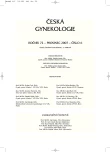Elective Single Embryo Transfer (eSET) - the Way to Decrease the Risk for Multiple Pregnancy
Authors:
R. Středa
Authors‘ workplace:
Centrum asistované reprodukce SANUS, Hradec Králové, prim. MUDr. J. Štěpán, CSc.
Published in:
Ceska Gynekol 2007; 72(6): 393-396
Category:
Original Article
Overview
Objective:
To present an overview of trials and discussion focused on the method of single embryo transfer leading to reduction of multiple pregnancy rate.
Subject:
Review article.
Setting:
Centre of Assisted Reproduction SANUS, Hradec Králové.
Subject and method:
Transfer of two embryos after IVF results in high multiple birth (25%) associated with increased morbidity for mother and children. Results of randomized controlled trials show that SET offers live birth rate approximately 35% with minimizing the risk of twins. The trials suggest to perform SET in a group of young women (≤ 36 years old), in the first or second cycle and only with sufficient number of good quality embryos.
Conclusions:
Data demonstrates that a single embryo transfer strategy, currently including one fresh single embryo transfer and one addition frozen-thawed SET, results in a live birth rate comparable with double embryo transfer and significantly reduces multiple birth rate.
Key words:
IVF, eSET, pregnancy rate, twins
Labels
Paediatric gynaecology Gynaecology and obstetrics Reproduction medicineArticle was published in
Czech Gynaecology

2007 Issue 6
Most read in this issue
- Pneumonia in Pregnancy
- How Exact Is the Performance of Mediolateral Episiotomy
- Vaginal Bacteriology in Women with Use of Sanitary Towels and Tampons During Menstruation
- Angiomyxoma of the Vulva – a Case Report
